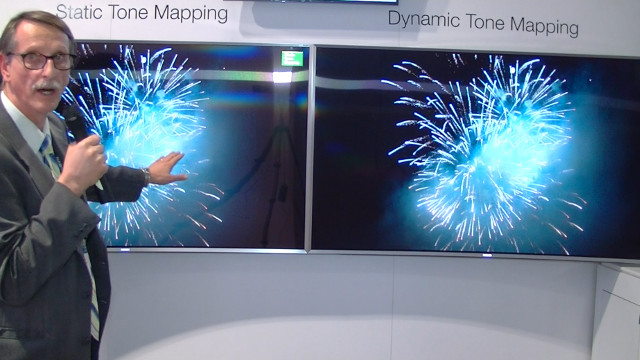Samsung used NAB to showcase for the first time, its dynamic metadata approach to HDR. The results were demonstrated in a side-by side demo on identical Samsung TVs – one showing the content with static metadata and the other with the dynamic metadata approach that Samsung is proposing to the SMPTE ST 2094 committee. (see video https://vimeo.com/164619204)
Samsung said this committee is now voting on proposed solutions from Samsung, Dolby, and Technicolor/Philips, but SMPTE refused to verify this. Samsung says they want to offer their approach to the industry on a royalty-free basis.
Samsung said that the TVs were identical except for the metadata being provided in the content. Creation of the dynamic metadata can be done manually or in an automated fashion. For professionals, Samsung has integrated their approach into the Resolve platform from Blackmagic Design and into Baselight, from Filmlight, as well as Autodesk from Adobe.
Samsung says they want to focus on an off-line approach to developing the metadata so it can be done by professionals and delivered to the consumer. The process adds no latency with current professional hardware solutions.
Samsung will add the decoding part of the metadata solution to its TV later in 2016 via a firmware upgrade. But it may also include the automated conversion feature as well for HDR content that does not have dynamic metadata.
It seems that the algorithm works by recognizing that in dark scenes, the image may be too dark overall for general use. While it may be fine for dark room viewing, once some light come on, the black level rises and the darker scenes are too muddy.
SDR TVs simply scale the range of luminance to the range of luminance on the TV, so you can turn the brightness up to improve viewing. But with HDR content pegged to the PQ EOTF, code values are locked to luminance values, so the end user can’t simply turn the brightness up – it won’t work as the TV is automatically set to the highest brightness level in HDR mode.
Therefore, the algorithm apparently recognizes where issue may occur – maybe by simply looking at the average picture level of the content – and making adjustments. These adjustments may be a modification of the PQ EOTF or simply adding a bias or offset in the curve – Samsung didn’t say.
The results were impressive and we look forward to watching the dynamic metadata debate and standardization efforts. – CC


